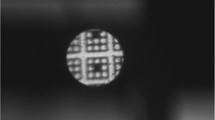Abstract
The accuracy of optical tracking systems is important to scientists. With the improvements reported in this regard, such systems have been applied to an increasing number of operations. To enhance the accuracy of these systems further and to reduce the effect of synchronization and visual field errors, this study introduces a field-programmable gate array (FPGA)-based synchronization control method, a method for measuring synchronous errors, and an error distribution map in field of view. Synchronization control maximizes the parallel processing capability of FPGA, and synchronous error measurement can effectively detect the errors caused by synchronization in an optical tracking system. The distribution of positioning errors can be detected in field of view through the aforementioned error distribution map. Therefore, doctors can perform surgeries in areas with few positioning errors, and the accuracy of optical tracking systems is considerably improved. The system is analyzed and validated in this study through experiments that involve the proposed methods, which can eliminate positioning errors attributed to asynchronous cameras and different fields of view.











Similar content being viewed by others
References
García-Vázquez, V., Marinetto, E., Santos-Miranda, J. A., Calvo, F. A., Desco, M., and Pascau, J., Feasibility of integrating a multi-camera optical tracking system in intra-operative electron radiation therapy scenarios. Phys. Med. Biol. 58(24):8769–8782, 2013.
Lü, Y., Li, C., Liu, M., Fritz, J., Carrino, J. A., Wu, L., and Zhao, B., MRI-guided stereotactic aspiration of brain abscesses by use of an optical tracking navigation system. Acta Radiol. 55(1):121–128, 2014.
Cheng, T. Y., and Herman, C., Motion tracking in infrared imaging for quantitative medical diagnostic applications. Infrared Phys. Technol. 62:70–80, 2014.
Vaccarella, A., De Momi, E., Enquobahrie, A., and Ferrigno, G., Unscented Kalman filter based sensor fusion for robust optical and electromagnetic tracking in surgical navigation. IEEE Trans. Instrum. Meas. 62(7):2067–2081, 2013.
Yang, R., Wang, Z., Liu, S., and Wu, X., Design of an accurate near infrared optical tracking system in surgical navigation. J. Lightwave Technol. 31(2):223–231, 2013.
Cheng, P., Jhiang, S. M., and Menq, C. H., Real-time visual sensing system achieving high-speed 3D particle tracking with nanometer resolution. Appl. Opt. 52(31):7530–7539, 2013.
Ohtani, K., and Baba, M., A high-speed, high-accuracy optical position sensor integrated with an analog and digital signal-processing circuit. Electron. Commun. Jpn. 94(12):12–21, 2011.
Schuppe, O., An optical tracking system for a microsurgical training simulator. Stud. Health Technol. Inform. 173:445–449, 2012.
Blostein, S. D., and Huang, T. S., Error analysis in stereo determination of 3-D point positions. IEEE Trans. Pattern Anal. Mach. Intell. 9(6):752–765, 1987.
Olague, G., and Mohr, R., Optimal camera placement for accurate reconstruction. Pattern Recogn. 35(4):927–944, 2002.
Helm, P. A., Teichman, R., Hartmann, S. L., and Simon, D., Spinal navigation and imaging: history, trends, and future. IEEE Trans. Med. Imaging 34(8):1738–1746, 2015.
Wiles, A. D., Thompson, D. G., and Frantz, D. D., Accuracy assessment and interpretation for optical tracking systems. Proc. SPIE Int. Soc. Opt. Eng. 5367:421–432, 2004.
Yang, R., Cheng, S., and Chen, Y., Flexible and accurate implementation of a binocular structured light system. Opt. Lasers Eng. 46(5):373–379, 2008.
Acknowledgments
This research was funded by the National Natural Science Foundation of China under Grant No.61505037, the Guangdong Natural Science Foundation under Grant No.S2013040014993, the State Scholarship Fund under Grant CSC NO.201408440326, the Pearl River S&T Nova Program of Guangzhou under Grant No.2014J2200049 and No.201506010035, the Guangdong Provincial Science and Technology Program under Grant No.2013B090600057 and No.2014A020215006, the Fundamental Research Funds for the Central Universities under Grant No.2014ZG003D, the Natural Scientific Foundation of Guangxi under Grant No.2015GXNSFBA139259.
Author information
Authors and Affiliations
Corresponding author
Additional information
This article is part of the Topical Collection on Systems-Level Quality Improvement.
Rights and permissions
About this article
Cite this article
Cai, K., Yang, R., Chen, H. et al. Synchronization Design and Error Analysis of Near-Infrared Cameras in Surgical Navigation. J Med Syst 40, 7 (2016). https://doi.org/10.1007/s10916-015-0368-2
Received:
Accepted:
Published:
DOI: https://doi.org/10.1007/s10916-015-0368-2




